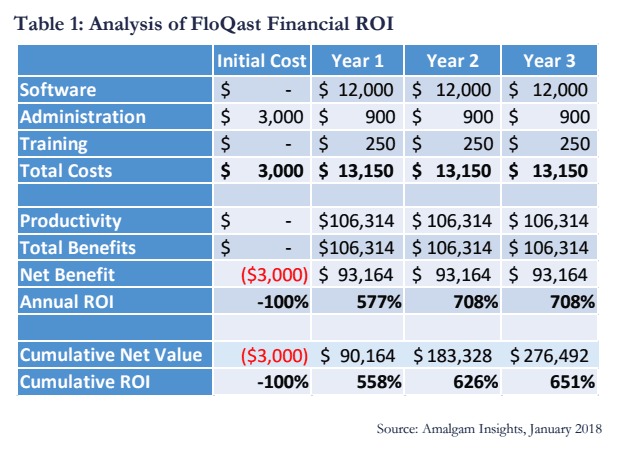Related blogs
Featured Resources
Sign Up for Emails from FloQast
Get accounting insights delivered directly to your inbox!
Thank you! Your submission has been received!
Oops! Something went wrong while submitting the form.
So, you’re sold on the benefits of moving from old technology to the latest cloud accounting software for your accounting team.But how do you get the C-Suite on board? Your CFO or CEO may not be as eager as you are to sign up for yet another cloud-based software subscription, especially if it’s not already in the budget.Now is the time to prepare a formal Business Value Analysis.What’s a Business Value Analysis? Don’t worry, it’s not complicated:
A Business Value Analysis is a holistic view of a technology investment that includes the financial value, the executive perception, and the employee perspective of how this technology improves their working environment. By viewing an investment through the lenses of money, C-level visibility, and operational productivity, a Business Value Analysis provides companies with a multi-faceted set of perspectives regarding how a technology will affect their organizations.
In other words, it’s not just your typical return on investment analysis, but presents additional dimensions as to the overall value of a solution — important aspects for the decision making process, which too often get overlooked.[caption id="attachment_8700" align="alignnone" width="200"]

Hyoun Park[/caption]Hyoun Park, Principal Analyst and CEO of Amalgam Insights, recommends that a solid Business Value Analysis contain the following three sections:
- Collaborative Value
- Executive Value
- Financial ROI
Of course, you don’t have to limit your own analysis to these three sections, but it’s a helpful starting point.
Collaborative Value
This focuses on the benefits to the team of enhanced business collaboration. Be sure to touch on the myriad ways that the software helps the team work better together.Most cloud accounting solutions improve one or more of the following:
- Accountability
- Automation
- Communication
- Completeness
- Controls
- Convenience
- Documentation
- Efficiency
- Flexibility
- Integration
- Sharing
- Standardization
- Transparency
- Visibility
It's difficult (perhaps impossible) to quantify the monetary value of the above elements, but they can make or break an accounting team in terms of productivity and employee satisfaction. And we all know how tough turnover can be.
Executive Value
This is the value to the C-Suite in adopting the new technology. To get buy-in from the top, it’s important to demonstrate to the CEO, CFO, and CIO that the new software will directly help them in addition to the team as a whole.Using FloQast as an example, we demonstrate how closing the books several days faster each month leads to the CFO getting the financials sooner. That means he or she has more time to do analysis before presenting results to the CEO and board, which makes the CFO’s job easier and gives the CFO the opportunity to be more strategic, and thus more valuable to the organization.
Financial ROI
This final section is frequently one of the most focused on areas of analysis when evaluating a new solution, and for good reason. Here is where the numbers come into play.If you can demonstrate a high Return on Investment (ROI) of implementing new software, it’s going to be hard for anyone to argue against making a change. This is easier for revenue generating departments such as sales, where investments can directly influence the top line. It’s more difficult for departments such as accounting, where improved performance is not so easy to quantify. That just means that accountants have to work a bit harder to get across the financial ROI value of adopting new technology.In doing your research, be sure to quantify time savings as a result of:
- Fewer meetings
- Less time spent on manual processes
Costs
When you assemble your spreadsheet, we suggest grouping your costs as follows:
- Software — The monthly subscription fee. If quarterly or annual, prorate the amount
- Setup — The financial impact of setup fees, as well as the cost of the team’s time to get up and running on the new system
- Administration — The internal cost of someone’s time to administer the application on an ongoing basis
- Training — The cost of training, both up front and ongoing, for the team
Benefits
Use the time savings estimates to quantify the monetary benefit of the new software. For example (taken from Amalgam’s FloQast Business Value Analysis:
The average accountant based in the United States had an annual salary of roughly $68,150 per year in 2016. The fully-loaded cost of that employee is approximately 1.3 times this salary, or $88,595. On a weekly basis, this would be about $1771.90 based on 50 weeks per year or $354.38 per day. A five person team collectively saving 25 days per month would save 5 team members * 5 days * 354.38 cost/employee/day or $8,860 total cost per month. That’s $106,320 per year.
ROI
Subtract the Total Benefits from the Total Costs to arrive at Net Benefit. Divide the Net Benefit by the Total Costs and you have your Return on Investment. It’s particularly easy to sell the C-Suite on new applications when you can demonstrate a positive ROI in Year 1:[caption id="attachment_8699" align="alignnone" width="617"]

An analysis of FloQast's financial ROI for a five person team[/caption]
Join our Business Value Analysis webinar
For a walkthrough of how to create your own Business Value Analysis, join Hyoun Park of Amalgam Insights on February 27 for a webinar entitled “Making the Case for Cloud Accounting Technology and How to Sell it to Your CEO - A Case Study.”You’ll learn how to conduct a thorough business value analysis of a cloud accounting software so that you can win your CEO’s approval.




.svg)

